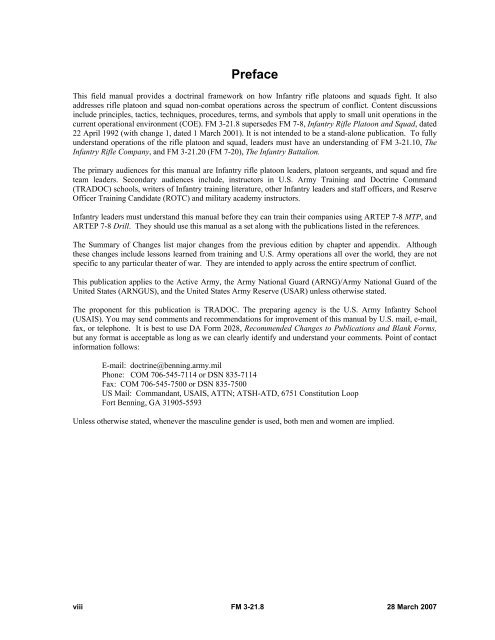Infantry Rifle Platoon and Squad - Sakai
Infantry Rifle Platoon and Squad - Sakai
Infantry Rifle Platoon and Squad - Sakai
Create successful ePaper yourself
Turn your PDF publications into a flip-book with our unique Google optimized e-Paper software.
Preface <br />
This field manual provides a doctrinal framework on how <strong>Infantry</strong> rifle platoons <strong>and</strong> squads fight. It also<br />
addresses rifle platoon <strong>and</strong> squad non-combat operations across the spectrum of conflict. Content discussions<br />
include principles, tactics, techniques, procedures, terms, <strong>and</strong> symbols that apply to small unit operations in the<br />
current operational environment (COE). FM 3-21.8 supersedes FM 7-8, <strong>Infantry</strong> <strong>Rifle</strong> <strong>Platoon</strong> <strong>and</strong> <strong>Squad</strong>, dated<br />
22 April 1992 (with change 1, dated 1 March 2001). It is not intended to be a st<strong>and</strong>-alone publication. To fully<br />
underst<strong>and</strong> operations of the rifle platoon <strong>and</strong> squad, leaders must have an underst<strong>and</strong>ing of FM 3-21.10, The<br />
<strong>Infantry</strong> <strong>Rifle</strong> Company, <strong>and</strong> FM 3-21.20 (FM 7-20), The <strong>Infantry</strong> Battalion.<br />
The primary audiences for this manual are <strong>Infantry</strong> rifle platoon leaders, platoon sergeants, <strong>and</strong> squad <strong>and</strong> fire<br />
team leaders. Secondary audiences include, instructors in U.S. Army Training <strong>and</strong> Doctrine Comm<strong>and</strong><br />
(TRADOC) schools, writers of <strong>Infantry</strong> training literature, other <strong>Infantry</strong> leaders <strong>and</strong> staff officers, <strong>and</strong> Reserve<br />
Officer Training C<strong>and</strong>idate (ROTC) <strong>and</strong> military academy instructors.<br />
<strong>Infantry</strong> leaders must underst<strong>and</strong> this manual before they can train their companies using ARTEP 7-8 MTP, <strong>and</strong><br />
ARTEP 7-8 Drill. They should use this manual as a set along with the publications listed in the references.<br />
The Summary of Changes list major changes from the previous edition by chapter <strong>and</strong> appendix. Although<br />
these changes include lessons learned from training <strong>and</strong> U.S. Army operations all over the world, they are not<br />
specific to any particular theater of war. They are intended to apply across the entire spectrum of conflict.<br />
This publication applies to the Active Army, the Army National Guard (ARNG)/Army National Guard of the<br />
United States (ARNGUS), <strong>and</strong> the United States Army Reserve (USAR) unless otherwise stated.<br />
The proponent for this publication is TRADOC. The preparing agency is the U.S. Army <strong>Infantry</strong> School<br />
(USAIS). You may send comments <strong>and</strong> recommendations for improvement of this manual by U.S. mail, e-mail,<br />
fax, or telephone. It is best to use DA Form 2028, Recommended Changes to Publications <strong>and</strong> Blank Forms,<br />
but any format is acceptable as long as we can clearly identify <strong>and</strong> underst<strong>and</strong> your comments. Point of contact<br />
information follows:<br />
E-mail: doctrine@benning.army.mil<br />
Phone: COM 706-545-7114 or DSN 835-7114<br />
Fax: COM 706-545-7500 or DSN 835-7500 <br />
US Mail: Comm<strong>and</strong>ant, USAIS, ATTN; ATSH-ATD, 6751 Constitution Loop<br />
Fort Benning, GA 31905-5593<br />
Unless otherwise stated, whenever the masculine gender is used, both men <strong>and</strong> women are implied.<br />
viii FM 3-21.8 28 March 2007

















